 |
 |
 |
| |
TMC125 safety and tolerability: 24-week results of the pooled DUET-1 and -2 trials
|
| |
| |
Reported by Jules Levin
IDSA, San Diego, Oct 7, 2007
R Haubrich, M Schechter, S Walmsley,
M Peeters, M Janssens, G De Smedt
on behalf of the DUET-1 and DUET-2 study groups
AUTHOR SAFETY CONCLUSIONS from DUET
Assessing safety/ tolerability of this new agent in a complex background was facilitated by the placebo-controlled design
Safety and tolerability of TMC125 was similar to placebo
Rash, the only AE to occur more frequently with TMC125
- generally mild to moderate
- often resolved with continued treatment
- associated with low discontinuation (2% versus 0% with placebo)
Overall, most AEs were of low severity and infrequently led to discontinuation
- 6% vs 4% in the TMC125 vs placebo groups
TMC125 was not associated with any increase in laboratory abnormalities, including hepatic and lipid parameters
TMC125 provides a tolerable new option for treatment-experienced patients
- not associated with common NNRTI side effects

Inclusion criteria
-- plasma viral load >5,000 HIV-1 RNA copies/mL and stable therapy for
≥8 weeks
-- ≥1 NNRTI mutations, current or documented historical
-- ≥3 primary PI mutations
sites: Thailand, Australia, Europe and the Americas
From extended list of NNRTI mutations; BR = background
regimen; DRV/r = darunavir with low-dose ritonavir; RAM = resistance-associated mutation
Baseline characteristics
and treatment duration
- 90% men. 70% Caucasians.
- 4.8 log viral load. 37% >100,000 viral load.
- Median cd4 count: 99-109. Cd4 count <50: 36%.
- CDC category C: 58%. Hepatitis B/C: 13%.
- Psychiatric symptoms: 46% in TMC group, 42% in placebo.
- NNRTI-associated rash: 8% in TMC group, 14% in placebo.
- Prior ARV use: 10 or more ARVs: 80% in TMC group, 83% in placebo.
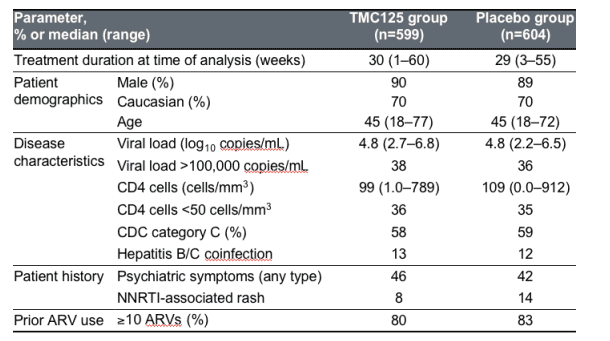
Overview of AEs
There is no difference in table between placebo and tmc125 groups regarding any AE, grade 4 (7% v 9%) or grade 3 AE (22% vs 25%, tmc v PLB), serious AE (!#% v 19%), there were 6% discontinuations due to AE in TMCgroup and 4% in placebo.
--Rash of any type: 17% in TMC group, 9% in placebo (p=0.0001). Diarrhea: 15% TMC, 20% PLB. Nausea: 14% TMC, 11% PLB. Headache: 9% TMC, 12% PLB.
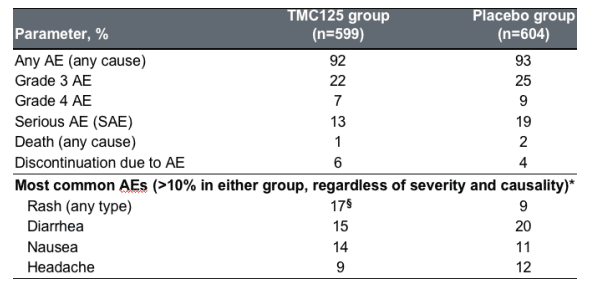
-- AEs leading to death were not reported in more than one patient except for pneumonia and sepsis (n=2 each) in the placebo group
-- None of the deaths in the TMC125 group were considered related to TMC125
*excluding injection site reactions; p=0.0001 vs placebo; AE = adverse event
Grade 3 and 4 AEs
Any grade 3-4 AE: n= 25 in TMC, 27 in PLB.
Most Common grade 3-4 clinical AEs (>0.5% in pooled TMC125 group)*
Rash (any type): 1.3% TMC, 0 PLB
Peripheral neuropathy: 1.0% TMC, 0 PLB.
Pancreatitis: 0.7% TMC, 0 PLB
Pneumocystis jiroveci pneumonia: 0.7& TMC, 0.7% PLB.
Renal failure: 0.7% TMC, 0.3% PLB.
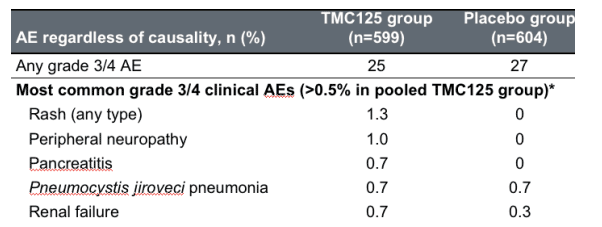
*excluding injection site reactions and grade 3/4 laboratory abnormalities reported as AEs
Rash
Any cause rash: 17% in TMC group; 9.4% PLB (P<0.001)
Possibly related to study medication: 12% TMC, 4.8% PLB.

In the TMC125 group:
- Early onset: median 12 days
- Limited duration: median 11 days
- Low severity: most mild to moderate; 1.3% grade 3, none grade 4
mostly maculopapular; no mucosal involvement
- Infrequently led to discontinuation: 2.2% of patients (0% with placebo)
most resolved with continued treatment
Clinical associations with rash
- No association with baseline CD4 cell count
- No increased risk with prior NNRTI-related rash
Incidence of rash by gender
- Higher incidence in women: 28% vs 16% in men: grade 3 - 1.1% in men, 3.3% in women; leading to permanent discontinuation: 1.9% in men, 5.0% in women.
- No clear difference in severity or discontinuations between genders

Incidence and prevalence of rash (any type) by treatment group
In this graph, prevalence in higher during first 4 weeks with TMC, during week 4-8 prevelance declines and after week 8 prevalence in both groups is similar. Incidence is also higher with TMC during first 2 weeks and after that incidence is a little higher in the TMC group but the difference between groups appears much less and after week 12 there appears to be no difference between treatment groups.
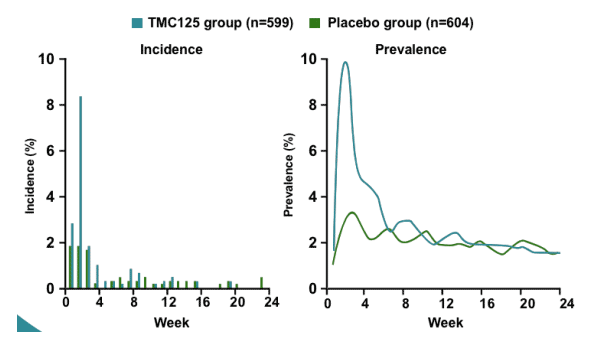
Nervous system*
*Includes only nervous system events associated with the use of approved NNRTIs
- Similar incidence to placebo: 15% in TMC125 group versus 18% in placebo group (p=0.09)
- Low severity: mostly grade 1 and 2
- Did not lead to discontinuation: none in TMC125 group and 1.0% of placebo group
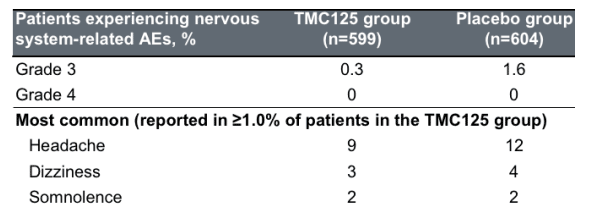
Psychiatric Disorders
Similar incidence to placebo: 13% in TMC125 group versus 15% in placebo group (p=0.3)
Low severity: mostly grade 1 and 2
Infrequently lead to discontinuation: 1 patient (0.2%) in each group
No increased risk in patients with a history of psychiatric disorders
Abnormal dreams/nightmares in 5 patients (0.8%) in each group and no episodes of hallucinations, suicidal ideation or manic symptoms with TMC125
AEs: grade 3- 0.2% TMC, 1.3% PLB. Grade 4- 0 TMC, 0.2% PLB.
Most Common (reported in 1.0% or more of patients in the TMC group:
Insomnia: 6% TMC, 7% PLB.
Depression: 3% TMC, 5% PLB.
Anxiety: 3% TMC, 3% PLB.
Sleep disorder: 1% TMC, 1% PLB.

Hepatic AEs and laboratory abnormalities
Any cause or severity for hepatic events: 5.3% TMC, 5.1% PLB.
Grade 3-4: 3.8% TMC, 3.1% PLB.
Grade 3-4 in hepatitis coinfected patients: 4.2% TMC, 4.4% PLB.
Leading to discontinuation: 0.7% TMC, 0.7% PLB.
Lab abnormalities: ALT elevated (grade 3-4): 1.9% & 0.7% TMC, 1.3% & 0.3% PLB.
AST: (AST elevated grade 3 &4)- 2.0% & 0.5% TMC, 1.3% & 0.3% PLB.
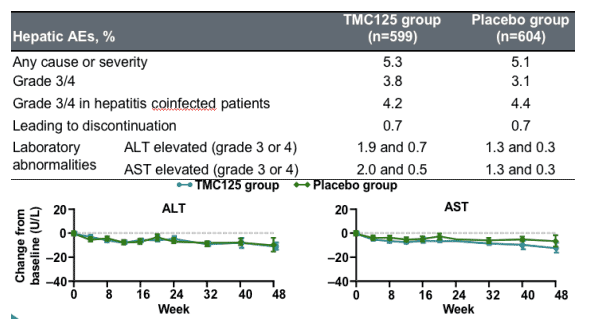
Treatment-emergent
laboratory abnormalities
Most Common (>2% in TMC group) grade 3-4 lab abnormalities)
From Jules: it might be helpful to see baselines values of patients regarding these on-treatment emergent differences,
Triglycerides (>750mg/dL): 7.0% TMC, 4.3% PLB.
Total chol (>300mg/dL): 5.8% TMC, 4.1% PLB.
Increased LDL (>189 mg/dl): 5.2% TMC, 5.4% PLB.
Increased ALT (>5x ULN): 2.5% TMC, 1.7% PLB.
Increased AST (>5x ULN): 2.5% TMC, 1.7% PLB.
Increased glucose (>249 mg/dL): 2.5% TMC v 1.7% PLB.

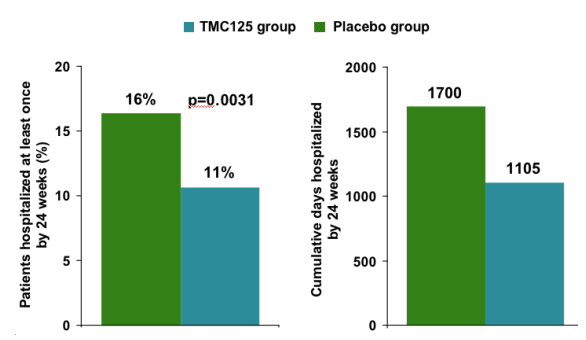
|
| |
|
 |
 |
|
|